Cultural Resources
| |
|
|
  |
 
|
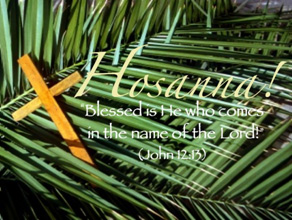 PALM SUNDAY
CULTURAL RESOURCES
PALM SUNDAY
CULTURAL RESOURCES
Sunday, March 16, 2008
Juan Floyd-Thomas, Guest Cultural Resource Commentator
Associate Professor of History, Texas Christian University, Fort Worth, TX
Lection - Luke 19:28-40 and
Zechariah 9:9-14 (New Revised Standard Version)
I. Introduction
Palm Sunday is a celebration that occurs on the sixth and final
Sunday of the Lenten season, and the week before Easter Sunday.
This special day is also known as Passion Sunday in some traditions.
The feast commemorates the jubilant celebration of Jesus’ arrival into
Jerusalem in the days prior to his arrest, trial, and execution as reported
in the Passion narratives of the four Gospels. On the first Palm Sunday, Jesus
affirmed himself as Messiah by his victorious ride into Jerusalem as the crowds sang his praises.
His entrance into Jerusalem on the back of a lowly colt to fulfill the prophetic
predictions of his destiny creates an ironic vision. We see how Jesus embodied
the deepest levels of humility and a show of non-violence all while knowing that
the road he was on surely led to the cross on Calvary and beyond. Nonetheless,
undaunted and undeterred by this knowledge, Jesus moved through the crowds towards
his certain destiny. That, above all, is what is recognized on Palm Sunday.
Origins of Palm Sunday
The liturgical significance of this particular Sunday signifies the extremes of majesty
and mourning in the joyous array of palms as well as the sobering account of the
Passion narrative of Jesus from the Synoptic Gospels. In this regard, it is always
important to recognize through visual, ritual, oral, and musical cues that this occasion
is a bittersweet occasion that prepares those who celebrate this day for the tragedy of Crucifixion,
yet proclaims the victory of the Resurrection.
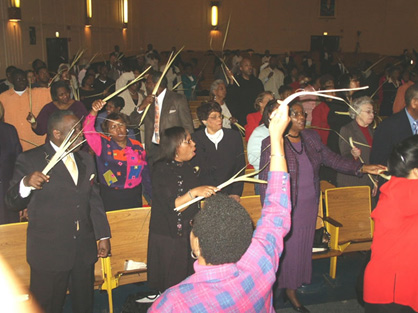
II. Palm Sunday Customs
Customarily, worshippers in many churches receive palm branches on Palm Sunday. There have been, however, historical
situations wherein it has been either impossible or impractical to acquire palm branches; adequate substitutes
(e.g. Yew tree branches) were found and utilized in those instances. The ways in which the palms are used and
incorporated into the Palm Sunday observances will vary depending on the style of worship dictated by a specific
congregation or denomination. In some cases, contemporary worshippers will reenact the joyous celebration of Jesus’
entry into Jerusalem by waving of palm branches and singing songs of celebration as central parts of the Palm Sunday liturgy.
Sometimes this is accompanied by a processional into the church. In other settings, there will be the distribution of palm
branches or leaves in their natural form or, more often, fashioned in the shape of a cross or loop in order to be pinned
onto each worshipper that day. For many churchgoers, the lush greenery that typically fills the church sanctuary during
this period of the Lenten season, especially the sight of palms and Easter lilies, has a wonderfully transformative effect
in terms of embracing the concepts of rebirth and renewal as central to Lent and ultimately Easter.
The liturgical color for the Lenten season in most Protestant traditions is purple, which is used until Easter Sunday.
Catholic tradition, however, the color for Palm Sunday is red, representing not only the color of the church but also being used
for Pentecost as well as remembering the martyrs of the church. Since it symbolizes shed blood, the incorporation of red is also
used on Palm Sunday to commemorate and reflect upon the death of Jesus
.
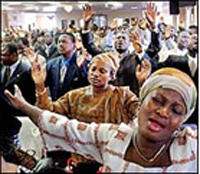 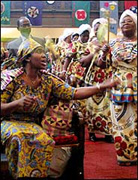
Increasingly, as a fairly recent development which bespeaks a definite sign of the times, many
churches are placing greater emphasis on the Passion of Jesus in Palm Sunday services in order
to balance the celebration of Easter Sunday. Rather than having both Sundays focus on triumph, Palm
Sunday is presented as a time to reflect on the suffering and death of Jesus during Sunday worship service.
Additionally, this reworking of Palm Sunday into Passion Sunday provides an opportunity for people who
either do not or cannot attend a Good Friday service to experience the contrast of Jesus’ death and the
Resurrection, rather than celebrating the Resurrection completely separate from Jesus’ suffering. However,
even a purposeful emphasis on the Passion of Jesus on this Sunday should not be as somber and downbeat
in tone as those worship services typical of Good Friday.
III. Palm Sunday in African American Visual Art
There are several depictions of Palm Sunday as rendered by African American artists such as Jacob Lawrence and Romare Bearden.
In his painting, Palm Sunday,1 Lawrence offers a modern depiction of the Palm Sunday celebration through
his use of bold colors and dynamic arrangement of shapes and lines. Moreover, using the scene of a
Black male pastor greeting and embracing congregants, especially children, is not only very befitting
the spirit of Palm Sunday, but also represents the vibrancy and vitality of this particular Sunday as
the near climax of the Lenten season. Likewise, Romare Bearden’s Palm Sunday Procession2 attempts
to re-imagine the celebratory spirit of Jesus’ entry into the city of Jerusalem in a more updated representation
of this triumphant event in the life and ministry of Jesus. Bearden’s painting takes on a deeper significance because,
although he was neither a committed nor a consistent churchgoer in his adult years, he uses scenes such as this to
illustrate how religious ceremonies and rituals are a key part of African American life and culture.
IV. Children and Youth and Palm Sunday Services
Another important element of Palm Sunday celebrations for many churches is the inclusion of
children and teenagers into worship services. Whether talking about youngsters memorizing
their Easter poems for recitation in front of the entire church, having Youth Sunday coincide
with Palm Sunday so that the children are more prominent throughout the day’s worship, or having
the youth as key performers in the church’s music, dance, or drama ministry for an Easter pageant
or concert, it is vitally important that children—as a symbol of God’s ongoing affirmation of
new life and unconditional love in the community—are an integral part of this service.
In this regard, Palm Sunday activities for children and teenagers can consist of skits, recitations, and
poetry for Easter that engages the African American experience wherein children and youth can
enjoy everything from innovative uses of Gospel rap as well as more traditional songs and poems.
Many children become excited by their heightened involvement because, not only do they enjoy
the processions, performances, and similar activities as a part of worship, but it also provides
them great opportunities to be more significantly involved in the worship life of the church as a
community of Faith. In addition, this heightened level of activity amongst the children of the church
helps create lasting memories and commitments for a lifetime. This is very much in keeping with
the biblical instruction found in Proverbs 22:6 that one must “train up a child in the way;”
s/he should go, and when s/he is old, s/he will not depart from it. As preparation increases
towards the sacred ceremonial concerns surrounding the Palm Sunday celebration and the impending events
of Holy Week, many youngsters are equally affected by the excitement of the family gatherings being planned,
getting new Easter outfits, or the great expectation of Easter candy and holiday meals to come.
V. Palm Sunday in Song
As a central part of the Palm Sunday worship services, congregations should learn the songs such as the spiritual
"Ride On, King Jesus." The lyrics to the two versions of the spiritual are as follows:
“Ride On King Jesus”3
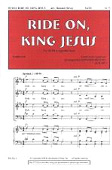
Ride on King Jesus!
No man can a-hinder me.
Ride on King Jesus!
No man can a-hinder me.
Well, ride on King Jesus!
No man can a-hinder me.
Oh, ride on King Jesus!
No man can a-hinder me.
King Jesus rides on a milk white horse
No man can a-hinder me.
The river of Jordan He did cross
No man can a-hinder me.
Oh, ride on King Jesus!
No man can a-hinder me.
Oh, ride on King Jesus!
No man can a-hinder me.
If you want to find your way to God
No man can a-hinder me.
The gospel highway must be trod
No man can a-hinder me.
Well, ride on King Jesus!
No man can a-hinder me.
Yes, ride on King Jesus!
No man can a-hinder me.
Oh, I was young when I begun
No man can a-hinder me.
But now my race is almost run
No man can a-hinder me.
Well, ride on King Jesus!
No man can a-hinder me.
Yes, ride on King Jesus!
No man can a-hinder me.
Well, ride on King Jesus!
No man can a-hinder me.
Oh, ride on King Jesus!
No man can a-hinder me
 Ride On King Jesus
Ride On King Jesus
Ride on King Jesus
No man can
-a-hinder me
Ride on King Jesus
Ride on
No man can-a-hinder me
No man can-a-hinder me
In that great getting up morning
Fair thee well, fair thee well
In that great getting up morning
Fair thee well, fair thee well
Ride on King Jesus...
In the song’s lyrics, Jesus is clearly heralded not only as a guardian and a conquering hero,
but also as a king as he crosses the Jordan River astride a white horse en route to the “promised land.”
As typical of the spirituals as a musical genre, "Ride On, King Jesus" contains a powerful and authentic
word of faith to the people of God. True to form, spirituals were used by the enslaved to express not
just the trials and tribulations, but also the hope of a better day. As important as that was in the era
of chattel slavery in America, to sing a song such as "Ride On, King Jesus" and take its meaning to heart
is most desperately needed in this present era of our history. Most importantly, it is vital that younger
members of the community of faith learn this and other spirituals in order to keep that musical form alive
within the black church tradition. Whether sung in a traditional or more contemporary rendition,
the worshippers can take solace and strength in the belief that, as the song’s lyrics suggests, no one
can hinder them with God on their side.4
Notes
- Lawrence, Jacob. Palm Sunday. 1956. Permanent collection: North Carolina Central University Art
Museum, NC. Online location: http://web.nccu.edu/ accessed 2 December 2007; Digital image of Jacob Lawrence’s painting,
Palm Sunday (1956): jlawrence palm sunday.jpg ../digital%20images/HIST%20images/BLST%20images/harlem%20renaissance/jlawrence%20palm%20sunday.jpg&
- Bearden, Romare. Palm Sunday Procession. 1967-68. National Gallery of Art, Washington, D.C. 12 Feb. 2008.
Online location: www.nga.gov
accessed 10 November 2007
- Contemporary rendition of "Ride On, King Jesus," by New Life Gospel Choir.
- Thomas, Velma Maia. No Man Can Hinder Me The Journey from Slavery to Emancipation Through Song. New York: Crown, 2001. p. 13.
|
| |
 
|
|

2013 Units

Multimedia
|